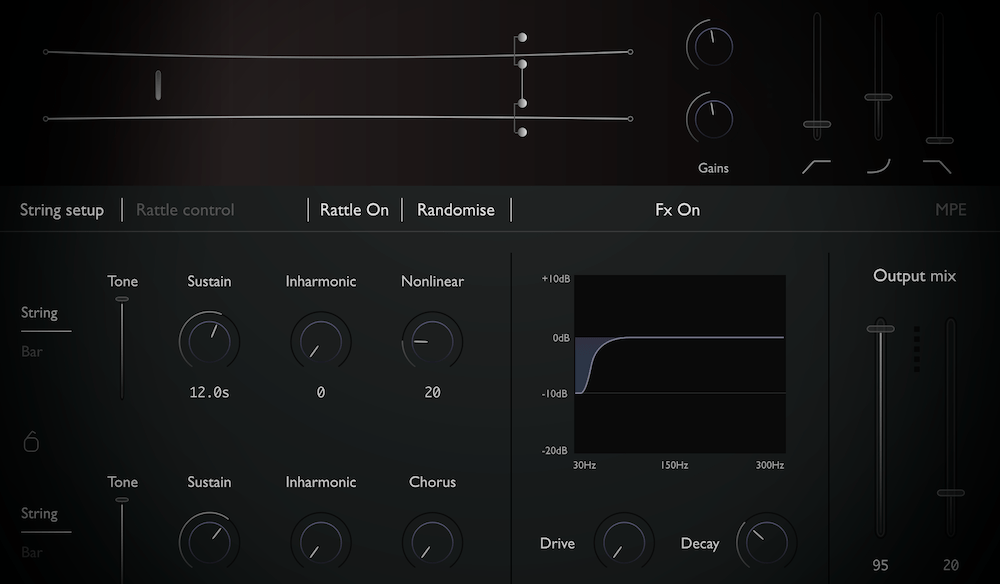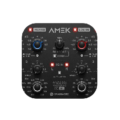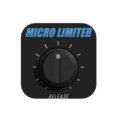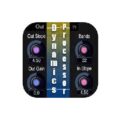Download Physical Audio Preparation full version program free setup for Windows. Preparation is a physical modelling instrument based on nonlinear models of strings and collisions.
Physical Audio Preparation Overview
Audio preparation refers to the process of organizing, optimizing, and enhancing audio content before its final use or distribution. This preparation can occur in various domains, including music production, audio engineering, film and video game sound design, broadcasting, and more. In music production, audio preparation involves activities such as recording, editing, mixing, and mastering. Musicians and producers work with raw audio tracks, arranging and editing them to create a cohesive and polished final piece. This process may also include tuning and time-aligning vocals and instruments, removing background noise, and applying various audio effects to achieve the desired artistic vision. For film and video game sound design, audio preparation includes selecting or creating appropriate sound effects, ambiances, and dialogues to match the visual content. Audio designers often manipulate and process audio elements to fit seamlessly into the overall audio mix, enhancing the immersive experience for the audience. You may also like Infected Sounds R3bel Free Download

In broadcasting, audio preparation is critical to ensure high-quality audio transmission. This may involve audio compression and encoding to optimize the data size while maintaining acceptable audio fidelity, as well as adhering to broadcasting standards for consistent audio levels and quality. With advancements in technology and the rise of virtual reality (VR) and augmented reality (AR) applications, audio preparation has become even more crucial. In these immersive experiences, realistic and spatial audio is vital for creating a sense of presence and enhancing the user’s overall experience. If “Physical Audio Preparation” has become a recognized term or specific process in the audio domain beyond my last update, I recommend referring to more recent sources or experts in the field for up-to-date and accurate information. The audio industry is continually evolving, and new concepts and techniques may have emerged since my last knowledge update.
Features
- Audio Recording: Capturing sound using microphones and other audio capture devices.
- Audio Editing: Trimming, rearranging, and manipulating audio segments to create a coherent composition.
- Pitch Correction: Adjusting pitch inaccuracies in vocal recordings or instruments.
- Time Alignment: Ensuring precise synchronization of multiple audio tracks.
- Noise Reduction: Removing unwanted background noise from audio recordings.
- Audio Restoration: Repairing damaged or deteriorated audio recordings.
- Equalization (EQ): Adjusting the balance of frequency components in audio signals.
- Dynamic Range Compression: Controlling the difference between the softest and loudest parts of an audio signal.
- Reverberation: Adding or adjusting the amount of room ambiance to audio.
- Audio Effects: Applying various creative effects such as delay, chorus, flanger, and more.
- Spatial Audio: Creating a three-dimensional audio experience for immersive content.
- Sound Design: Creating and manipulating audio elements for film, games, or multimedia.
- Audio Mixing: Balancing and blending individual audio tracks into a final mix.
- Mastering: Preparing a final mix for distribution, ensuring it sounds consistent across various playback systems.
- Audio Compression: Reducing the data size of audio files for efficient storage or transmission.
- Audio Encoding: Converting audio into specific file formats for various applications.
- Audio Metadata Tagging: Adding descriptive information to audio files for organization and cataloging.
- Audio Normalization: Adjusting the volume levels to a standard reference point.
- Audio Batch Processing: Automating repetitive audio tasks on multiple files.
- Audio Synthesis: Creating new sounds using electronic or digital means.
- Sampling: Extracting short segments of audio from existing recordings for use in new compositions.
- Audio Loops: Repetitive audio segments that can be seamlessly repeated in a musical context.
- Audio Fades and Crossfades: Gradually increasing or decreasing the volume of audio signals.
- Ducking: Automatically reducing the volume of one audio source when another is present.
- Multitrack Recording: Capturing and storing multiple audio sources independently.
- Audio Bouncing/Exporting: Rendering a final audio mix to a standard audio file format.
- Audio Time-Stretching: Altering the duration of an audio signal without changing its pitch.
- Audio Resampling: Changing the sample rate of an audio file.
- Audio Format Conversion: Converting audio between different formats.
- Audio Batch Export: Exporting multiple audio files simultaneously.
- Audio File Splitting/Merging: Dividing or combining audio files as needed.
- Normalization of Loudness: Ensuring consistent loudness levels across different audio tracks.
- Audio File Archiving: Organizing and storing audio files for long-term preservation.
- Audio Collaboration Tools: Facilitating remote collaboration among audio professionals.
- Audio Analysis Tools: Software for analyzing and visualizing audio characteristics.
- Audio Plugins: External software components used to extend the capabilities of audio software.
- MIDI Integration: Integrating MIDI (Musical Instrument Digital Interface) for controlling audio software and hardware.
- Audio Loop Libraries: Pre-recorded audio segments available for use in productions.
- Audio Rendering Options: Configuring various settings for the export and rendering of audio files.
Technical Details
- Software Name: Physical Audio Preparation for Windows
- Software File Name: Physical-Audio-Preparation-v1.1.8.rar
- Software Version: v1.1.8
- File Size: 2.66 MB
- Developers: physicalaudio
- File Password: 123
- Language: Multilingual
- Working Mode: Offline (You donÆt need an internet connection to use it after installing)
System Requirements
- Operating System: Win 7, 8, 10, 11
- Free Hard Disk Space:
- Installed Memory: 1 GB
- Processor: Intel Dual Core processor or later
- Minimum Screen Resolution: 800 x 600
What is the latest version of Physical Audio Preparation?
The developers consistently update the project. You can view the most recent software update on their official website.
Is it worth it to install and use Software Physical Audio Preparation?
Whether an app is worth using or not depends on several factors, such as its functionality, features, ease of use, reliability, and value for money.
To determine if an app is worth using, you should consider the following:
- Functionality and features: Does the app provide the features and functionality you need? Does it offer any additional features that you would find useful?
- Ease of use: Is the app user-friendly and easy to navigate? Can you easily find the features you need without getting lost in the interface?
- Reliability and performance: Does the app work reliably and consistently? Does it crash or freeze frequently? Does it run smoothly and efficiently?
- Reviews and ratings: Check out reviews and ratings from other users to see what their experiences have been like with the app.
Based on these factors, you can decide if an app is worth using or not. If the app meets your needs, is user-friendly, works reliably, and offers good value for money and time, then it may be worth using.
Is Physical Audio Preparation Safe?
Physical Audio Preparation is widely used on Windows operating systems. In terms of safety, it is generally considered to be a safe and reliable software program. However, it’s important to download it from a reputable source, such as the official website or a trusted download site, to ensure that you are getting a genuine version of the software. There have been instances where attackers have used fake or modified versions of software to distribute malware, so it’s essential to be vigilant and cautious when downloading and installing the software. Overall, this software can be considered a safe and useful tool as long as it is used responsibly and obtained from a reputable source.
How to install software from the WinRAR file?
To install an application that is in a WinRAR archive, follow these steps:
- Extract the contents of the WinRAR archive to a folder on your computer. To do this, right-click on the archive and select ”Extract Here” or ”Extract to [folder name]”.”
- Once the contents have been extracted, navigate to the folder where the files were extracted.
- Look for an executable file with a .exeextension. This file is typically the installer for the application.
- Double-click on the executable file to start the installation process. Follow the prompts to complete the installation.
- After the installation is complete, you can launch the application from the Start menu or by double-clicking on the desktop shortcut, if one was created during the installation.
If you encounter any issues during the installation process, such as missing files or compatibility issues, refer to the documentation or support resources for the application for assistance.
Can x86 run on x64?
Yes, x86 programs can run on an x64 system. Most modern x64 systems come with a feature called Windows-on-Windows 64-bit (WoW64), which allows 32-bit (x86) applications to run on 64-bit (x64) versions of Windows.
When you run an x86 program on an x64 system, WoW64 translates the program’s instructions into the appropriate format for the x64 system. This allows the x86 program to run without any issues on the x64 system.
However, it’s important to note that running x86 programs on an x64 system may not be as efficient as running native x64 programs. This is because WoW64 needs to do additional work to translate the program’s instructions, which can result in slower performance. Additionally, some x86 programs may not work properly on an x64 system due to compatibility issues.
What is the verdict?
This app is well-designed and easy to use, with a range of useful features. It performs well and is compatible with most devices. However, may be some room for improvement in terms of security and privacy. Overall, it’s a good choice for those looking for a reliable and functional app.
Download Physical Audio Preparation Latest Version Free
Click on the button given below to download Physical Audio Preparation free setup. It is a complete offline setup for Windows and has excellent compatibility with x86 and x64 architectures.










